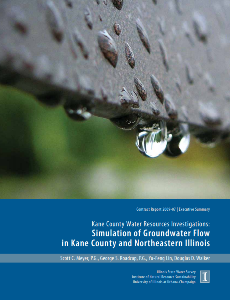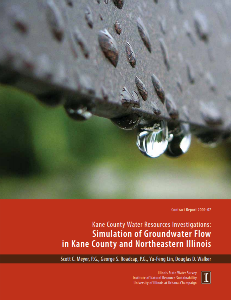Kane County Water Resources Investigations
Simulation of Groundwater Flow in Kane County and Northeastern Illinois
Kane County in northeastern Illinois has taken progressive steps to predict future water supply changes in order to avoid water shortages. The population in Kane County is projected to surge 70 percent from 2000 to the year 2030, undoubtedly boosting water demand. The county must consider its options to ensure continued availability of a clean water supply.
The Kane County Development Department commissioned the Illinois State Water Survey (ISWS) (and sister agency Illinois State Geological Survey) to determine the status of current and future groundwater resources in the county. ISWS researchers developed regional- and local-scale groundwater flow models, which are sets of interrelated mathematical equations that represent water flow in aquifers and streams. Computer programs are used to solve the equations, thereby determining the effects of current and future groundwater usage and stressors, such as drought.
Using computer models and other data and analyses, ISWS researchers predict that under low-pumpage, or conservative conditions, groundwater withdrawals in Kane County will increase from 37 million gallons per day (mgd) in 2003 to 52 mgd in 2050. Under high-pumpage conditions, however, groundwater withdrawals will increase to as much as 71 mgd.
Model simulations for Kane County also showed:
- Groundwater withdrawals will cause water levels in wells to decline, potentially causing water supply interruptions requiring well replacement, and increasing concentrations of radium, barium, arsenic, and salinity in water withdrawn from deep wells. In deep wells, drawdown, or declines in water elevation, will be greatest in the Aurora area.
- In shallow wells, ISWS researchers identified two large areas of significant drawdown in the Kane County area. The largest included parts of northeastern Kane County and southeastern McHenry County and resulted from pumping from various villages and cities, including Crystal Lake and Algonquin. A second area developed in response to pumping by the City of West Chicago. A third area will likely develop around public-supply wells operated at Batavia and Geneva.
- Water pumping had reduced groundwater discharge to streams by 17 percent in 2003 since the 19th century. The greatest reduction in groundwater discharge occurred in Mill Creek, upstream of Batavia. Researchers project that discharge to Mill Creek may end completely by 2050. Reduced streamflow can adversely affect the local ecology.
The modeling study is part of a comprehensive project assessing surface water, geology, and groundwater in Kane County. The Executive Summary and Full Report discuss modeling procedures and outcomes.

